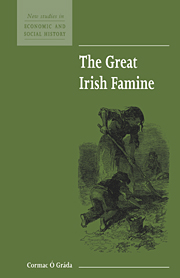Book contents
- Frontmatter
- Contents
- Preface
- Introduction
- 1 Population and potatoes: the pre-Famine context
- 2 The Great Hunger 1845–1850
- 3 Aftermath: Ireland after 1850
- 4 Conclusion
- Select bibliography
- Bibliographical update and commentary
- Glossary
- Index
- Titles available in the New Studies in Economic and Social History series
- Titles available in the Studies in Economic History series
- Economic History Society
2 - The Great Hunger 1845–1850
Published online by Cambridge University Press: 05 June 2012
- Frontmatter
- Contents
- Preface
- Introduction
- 1 Population and potatoes: the pre-Famine context
- 2 The Great Hunger 1845–1850
- 3 Aftermath: Ireland after 1850
- 4 Conclusion
- Select bibliography
- Bibliographical update and commentary
- Glossary
- Index
- Titles available in the New Studies in Economic and Social History series
- Titles available in the Studies in Economic History series
- Economic History Society
Summary
The arrival of Phytophthera infestans or potato blight in Ireland was first noted in the press on 6 September 1845. The ‘New Disease’ had already struck in the US in the summer of 1843. According to a contemporary account from there, ‘potatoes [were] subject to dry rot, attacking some in the hill, and some in the heap, and fatal to the whole wherever it makes its appearance, causing them to rot and emit a very offensive stench’. The blight then crossed the ocean by a mysterious route, reaching Ireland via Continental Europe and England. The news that Ireland had been hit caused the London Gardener's Chronicle to stop press, but local reports from Ireland were initially reassuring. Reaction in financial and commodity markets was minimal. Indeed the movement of potato prices on the Dublin market in the autumn of 1845 reflects this. Lumpers, which fetched 16d. to 20d. per hundredweight (or 50 kilos) in the second week of September, could still be bought for less than 18d. until near the end of November. (Then, it is true, prices rose beyond 2 shillings, and had passed 3 shillings by April 1846.) In political circles, however, the gravity of the situation soon became a ‘party’ issue: ‘to profess belief in … the existence of a formidable potato blight, was as sure a method of being branded a radical, as to propose to destroy the Church’.
- Type
- Chapter
- Information
- The Great Irish Famine , pp. 32 - 56Publisher: Cambridge University PressPrint publication year: 1995



